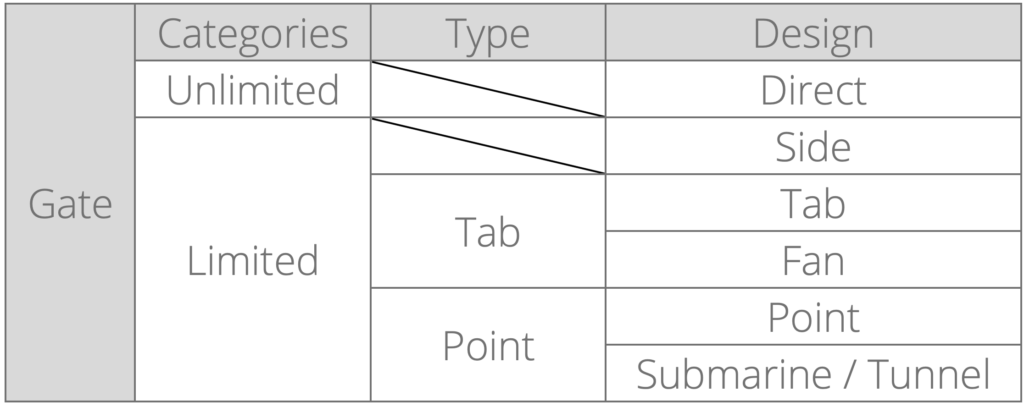Previously, we discussed Runner which is a system (path) of mold. It let plastic material flow travel from outside of mold into cavity area. In most cases, Gate located at the end of Runner, it is an entrance for material flow into cavity area. See concept in Pic.-1.

Note: Red: Runner system, Orange: location ring (a part of mold to connect to injection unit), Joint of red line and part: Gate (entrance of cavity)
Here discuss Gate design mostly used in mold designs based on my experience. They could be divided into 2 categories, limited and unlimited. The major difference between these 2 categories are the way material flow enters cavity, Limited type Gates are a turning point and Unlimited type Gate is not. See the category in Table-1.

Molds with unlimited gate design produces stronger parts. The parts receive more injection pressure and have most obvious gate mark. Therefore, the parts with unlimited type gate usually used for engineering instead of cosmetic purpose. The parts produced by molds with limited type gate usually used for cosmetic purpose. See advantages/disadvantages and concept of each type gates in below table.

The color of the concept in table-2 stands for Red: Runner, Blue: plastic part, Green: parting line, Light grey: mold, Dark grey: Ejector Pin.
Gate Location
Gate position can have a direct impact on part moldability, performance, appearance, and cost. The location of the gate determines the filling pattern and maximum material flow length. Ideally the gate would be positioned to balance filling and minimize flow length, typically near the center of the part or at strategic intervals for multi-gated parts. Often these best gate locations for filling are unacceptable for other reasons. For example, they might result in unsightly gate marks or weld lines in cosmetic areas, or increase mold construction costs. Cavity layout restrictions and mechanisms in the mold such as slides or lifters may also restrict gating to less than ideal locations. The best gate position is often a compromise between molding ease and efficiency, part performance and appearance, and mold design feasibility.